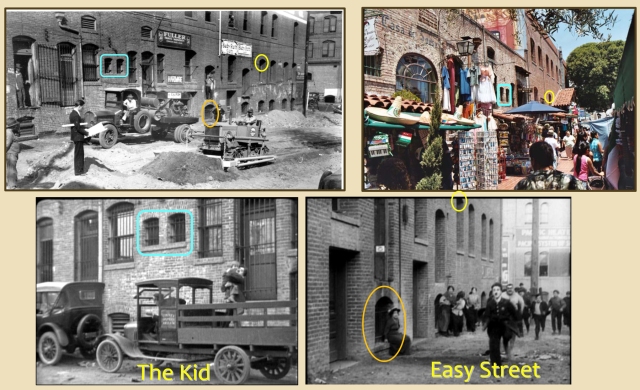 As I explain in my book Silent Traces, Charlie Chaplin’s landmark short film Easy Street (1917) contains scenes filmed on extant Olvera Street in downtown Los Angeles (see below), where he would return a few years later to film his re-union with Jackie Coogan in The Kid (1921) (see The Kid post HERE). The Easy Street “T” intersection exterior set (left), was built in Hollywood within the NE corner of
As I explain in my book Silent Traces, Charlie Chaplin’s landmark short film Easy Street (1917) contains scenes filmed on extant Olvera Street in downtown Los Angeles (see below), where he would return a few years later to film his re-union with Jackie Coogan in The Kid (1921) (see The Kid post HERE). The Easy Street “T” intersection exterior set (left), was built in Hollywood within the NE corner of  Cahuenga and Romaine at the tiny Lone Star Studio backlot, the same spot where Buster Keaton, after taking over the studio in 1920 for his own productions, would build a similar “T”-shaped tenement set for his short film Neighbors (1920) (right). [Note: Easy Street is now available in high definition Blu-ray, collaboratively restored by Serge Bromberg’s Lobster Films, Cineteca Di Bologna, and David Shepard’s Film Preservation Associates, as part of the Chaplin’s Mutual Comedies collection from Flicker Alley. The frame grabs on this post were taken from the prior DVD.]
Cahuenga and Romaine at the tiny Lone Star Studio backlot, the same spot where Buster Keaton, after taking over the studio in 1920 for his own productions, would build a similar “T”-shaped tenement set for his short film Neighbors (1920) (right). [Note: Easy Street is now available in high definition Blu-ray, collaboratively restored by Serge Bromberg’s Lobster Films, Cineteca Di Bologna, and David Shepard’s Film Preservation Associates, as part of the Chaplin’s Mutual Comedies collection from Flicker Alley. The frame grabs on this post were taken from the prior DVD.]
Despite reportedly spending $10,000 building his Easy Street set, Chaplin used a real police station (above) to film the scene where Charlie deliberates whether to join the force. His movements are a tour de force, showing the audience, through his physicality, his inner turmoil as he summons the courage to enter the building in order to enlist, then balks at the threshold, halting mid-step, then regains his nerve, marches towards the door, only to hesitate yet again. The scene was likely filmed in December 1916.
A few months earlier, Charlie’s friend Douglas Fairbanks filmed his comedy Flirting With Fate (1916) at the same police-station doorway (above).

Harry Langdon, left, in Plain Clothes (1925) – Stan Laurel, right, in Mixed Nuts (1922).
Following Charlie and Doug, the joint fire/police station, once standing at 1625-1627-1629 Cahuenga Boulevard, would become a very popular place to film. This makes perfect sense, as fire houses and police stations are commonly employed in all types of movies, and this was THE station serving most of Hollywood. I write much more about the joint station’s appearances in a prior post HERE. As shown above and below, Harry Langdon, Stan Laurel, Lloyd Hamilton, Harold Lloyd, and Buster Keaton all filmed in front of the station, and if I had to guess, nearly every other silent comedian likely filmed here as well.

Comedian Lloyd Hamilton’s turn – possibly The Movies (1925, dir. Roscoe Arbuckle), which staged scenes at the station.
The station appeared in Buster Keaton’s feature films Three Ages (1923) (above, right) and The Cameraman (1928), as well as in Harold Lloyd’s Safety Last! (1923) and Hot Water (1924) (above, left), and the early 1924 Our Gang short comedy High Society. The station no doubt appears in dozens of other films, including the newspaper drama The Last Edition (1925) (see below) reported HERE. What’s more, Keaton used the alley along the south side of the station for scenes from three different short films; The Goat (1921), Hard Luck (1921), and Neighbors (1920) (see post HERE).

Click to enlarge. Eric Campbell chases Charlie onto the Plaza de Los Angeles in Easy Street. USC Digital Library
Chaplin fashioned his tenement set for Easy Street after Methley Street, in his boyhood London neighborhood Lambeth. To add greater realism, he also filmed at the Plaza de Los Angeles (above), and nearby Olvera Street, a slum alley that is today a popular Mexican market and tourist attraction.
Above, four views of Olvera Street, a dingy slum alleyway at the time Chaplin filmed The Kid and Easy Street, reminiscent of his boyhood home (see more on The Kid at this post HERE). Today Olvera Street is one of LA’s most popular tourist spots.
All images from Chaplin films made from 1918 onwards, copyright © Roy Export Company Establishment. CHARLES CHAPLIN, CHAPLIN, and the LITTLE TRAMP, photographs from and the names of Mr. Chaplin’s films are trademarks and/or service marks of Bubbles Incorporated SA and/or Roy Export Company Establishment. Used with permission. Easy Street special edition (C) 2006 Film Preservation Associates.
Flirting With Fate (1916)—Douglas Fairbanks: A Modern Musketeer Collection (David Shepard, Film Preservation Associates, Jeffrey Masino, Flicker Alley LLC).
Neighbors (1920); Three Ages (1923) licensed by Douris UK, Ltd.
HAROLD LLOYD images and the names of Mr. Lloyd’s films are all trademarks and/or service marks of Harold Lloyd Entertainment Inc. Images and movie frame images reproduced courtesy of The Harold Lloyd Trust and Harold Lloyd Entertainment Inc.
Plain Clothes (C) 2007 All Day Entertainment and Lobster Films.
Site of the former Hollywood joint fire/police station








Pingback: The Keaton-Fairbanks Hollywood Fire Station | Chaplin-Keaton-Lloyd film locations (and more)